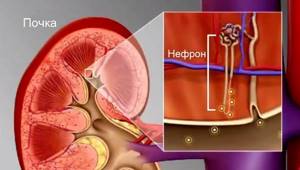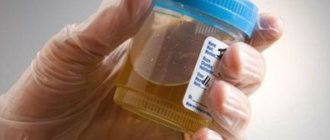Urine testing to detect microalbuminuria (MAU) is widely used in the diagnosis of the initial stages of renal tissue damage.
What is important is the quantitative determination of the level of urinary albumin, which is directly proportional to the degree of damage to the renal glomerulus (the main structural element of the kidney).
Microalbuminuria is the excretion of albumin protein in the urine in quantities exceeding physiological values.
Table 1 - Definition of microalbuminuria. Source - RMJ. 2010. No. 22. S. 1327
Physiological and pathological albuminuria
A healthy person excretes a small amount of protein molecules in the urine (up to 150 mg/dl), while the albumin content in it is less than 30 mg/dl.
The amount of protein excreted in urine can vary widely at different times of the day. Thus, at night, the excretion of albumin in urine is approximately 30-40% less, which is associated with a low level of vascular pressure and a horizontal body position. This leads to a decrease in renal blood flow and the rate of urine filtration in the glomerulus.
In an upright position, the level of albumin excretion in urine increases, and after physical activity it can briefly be in the range of 30-300 mg/l.
The amount of albumin excreted in urine may be influenced by the following factors:
- 1Diet high in protein;
- 2Hard physical labor;
- 3Urinary infection;
- 4 Circulatory failure;
- 5 Taking NSAIDs (non-steroidal anti-inflammatory drugs);
- 6Severe bacterial infection, sepsis;
- 7Pregnancy.
Taking antihypertensive drugs from the group of ACE inhibitors, on the contrary, reduces albumin secretion.
The rate of urinary excretion of albumin may also depend on age and race. Abnormal excretion of albumin in the absence of evidence of concomitant pathology of internal organs occurs in the elderly and Africans, and is often combined with excess weight.
Additional symptoms of microalbuminuria
At the onset of nephropathy, there are usually no symptoms. As the disease progresses, causeless fatigue, dry mouth, unmotivated thirst, and headache are noticed.
You may also be concerned about urinary problems (pain, cramps, frequent or night urination, urinary incontinence). In inflammatory diseases, heaviness in the lumbar region is bothersome.
In the later stages, edema, arterial hypertension and metabolic disorders appear (decreased albumin in the blood, increased creatinine and cholesterol).
Urine analysis for UIA - indications for use
Microalbuminuria (abbreviated MAU) is the earliest and most reliable sign of kidney tissue damage.
Since it is impossible to determine it using routine methods, testing urine for microalbuminuria is included in the standards for examining patients at risk, primarily in patients with established diabetes mellitus and arterial hypertension.
List of patients to be screened for microalbuminuria:
- 1Patients with any type of diabetes mellitus and a history of the disease of more than 5 years (once every 6 months);
- 2Patients with hypertension (once every 12 months);
- 3Patients after kidney transplantation to monitor the development of rejection reactions;
- 4Patients with chronic glomerulonephritis.
To whom and when is a UIA test prescribed?
Albumins are proteins produced by the liver. Normally, only small amounts of microalbumin pass through the renal filter. Microalbuminuria (more than 30 mg per day) appears in the first stages of nephropathy - kidney pathology.
A test for microalbuminuria is prescribed in the following cases:
- Diagnosis of kidney and cardiovascular diseases.
- Comprehensive examination for diabetes and hypertension. Analysis for MAU allows you to confirm damage to the nephrons.
- Assessing the correctness of treatment for arterial hypertension.
- Pregnancy (to exclude nephropathy in pregnant women).
Microalbuminuria should be detected on the recommendation of a doctor, even in the absence of symptoms. Its detection in the urine indicates the onset of nephropathy. This period is preclinical, so it is still possible to stop the progress of the disease.
Causes of damage to the renal glomerulus
Among the main causes of damage to the renal glomeruli, and therefore microalbuminuria, are:
- 1High glycemic level. MAU is the very first sign of diabetic nephropathy. The main mechanism for the occurrence of microalbuminuria in diabetes mellitus is hyperfiltration in the renal glomerulus and damage to the kidney vessels as a result of hyperglycemia. If left untreated, diabetic nephropathy rapidly progresses, leading to kidney failure and the need for hemodialysis. That is why every patient with diabetes mellitus should undergo a urine test for UIA at least once every six months, for early detection of nephropathy and its timely treatment.
- 2High level of systolic pressure. Hypertension is a systemic disease that affects a large number of organs and systems, including the kidneys. In this case, MAU is a sign of the development of kidney complications - hypertensive nephrosclerosis, which is based on increased filtration pressure, tubulointerstitial fibrosis and increased permeability of the vascular wall to protein. MAU is a self-sufficient risk factor for the development of complications of hypertension.
- 3Overweight, obesity, metabolic syndrome. Since 1999, WHO has defined microalbuminuria as one of the components of metabolic syndrome.
- 4Hypercholesterolemia and hypertriglyceridemia, which lead to the development of generalized atherosclerosis. MAU in this case reflects the phenomena of endothelial dysfunction and is directly related to increased cardiovascular risk.
- 5Chronic inflammation of the kidney tissue. The appearance of MAU (and proteinuria in general) is a prognostically unfavorable sign of the progression of glomerulonephritis.
- 6Smoking. In smokers, the excretion of albumin in urine is approximately 20-30% higher (Nelson, 1991, Mogestein, 1995), which is associated with nicotine damage to the vascular endothelium.
How to prepare for daily analysis
A urine test for microalbuminuria is best done in a hospital setting. However, with proper preparation, you can collect urine at home.
How to prepare for the UIA test:
- Two days before collecting the material, exclude alcohol, fatty, salty, and animal protein-rich foods. In addition, it is prohibited to consume foods with coloring substances (turmeric, beets, carrots, black berries).
- It is necessary to prepare a clean container; it is advisable to purchase a special sterile container for collecting daily urine.
- You cannot collect analysis during menstruation.
- Before each urine collection, you need to wash the perineum and genitals. Women should cover the vaginal opening with a cotton swab when urinating.

Proper preparation for analysis is the key to reliable results.
Method of determination
Pathological albuminuria is not detected by routine methods of urine examination, for example, by acid precipitation.
Given the significant daily variability in urinary albumin excretion, only the detection of MAU in two or three consecutive urine tests is diagnostically significant.
For a urine screening test for UIA, it is permissible to use specially designed test strips, but in case of a positive test using rapid tests, it is necessary to confirm pathological albuminuria using methods that allow determining the albumin concentration.
Semi-quantitative assessment is carried out using special strips - strip tests, where there are 6 gradations of albumin concentration in urine (“not detected”, “traces” - up to 150 mg/l, more than 300 mg/l, 1000 mg/l, 2000 mg/l). l, and more than 2 thousand mg/l). The sensitivity of this method is about 90%.
Quantitative determination is carried out using:
- 1Determination of the ratio of creatinine and albumin (C/A) in urine;
- 2Direct immunoturbidimetric method. The method allows you to estimate the albumin concentration by the turbidity of the solution obtained after the interaction of the protein with specific antibodies and the precipitation of immune complexes.
- 3Immunochemical method using the “HemoCue” system (immunochemical reactions using anti-human antibodies). Albumin-antibody complexes lead to the formation of a precipitate, which is subsequently captured by a photometer.
Why is albumin in urine elevated?
The kidneys are the body's natural filter, so they have a very developed vascular network. It is the blood vessels that deliver blood to the nephrons for filtration. Damage to the endothelium of the arteries, as well as the nephrons themselves, is accompanied by albuminuria in 90% of cases.
Physiological reasons
MAU can also appear in the urine of healthy people. This means that the result of the analysis is not a verdict. Therefore, additional research methods are needed.
When albumin in urine does not indicate illness:
- with large loss of fluid (profuse vomiting, diarrhea, etc.);
- after heavy physical exertion;
- in women, the cause of UIA may be taking the test during menstruation or without blocking the vaginal opening;
- during a high protein diet (ketogenic, Dukan).
If there is any doubt about the diagnosis, the doctor recommends repeating the test.
Deviations in health status
Microalbumin in urine is a precursor to kidney failure. He talks about the initial stage of nephropathy.

If MAU is detected, changes in the glomerular system are still reversible. Therefore, the analysis should be carried out for all people with suspected kidney damage.
What diseases are accompanied by microalbuminuria:
- Dysmetabolic nephropathy. These are kidney diseases caused by metabolic disorders. Diabetes of the 1st and 2nd types most often leads to this type of nephropathy. All patients with diabetes should be tested regularly for UIA.
- Kidney pathology caused by arterial hypertension and other cardiovascular diseases. The kidneys are a target for these diseases.
- Reflux nephropathy (RN). A disease that occurs against the background of vesicoureteral reflux (VUR). Most often the disease affects children. PMR often occurs without symptoms. Therefore, regular examination of children with suspected VUR is necessary.
- Glomerulonephritis. The disease is of an autoimmune nature. Almost always, with glomerulonephritis, people lose a lot of protein in their urine.
- Pyelonephritis.
- Hypothermia.
- Renal vein thrombosis.
- Polycystic kidney disease.
- Nephropathy in pregnant women.
- Systemic lupus erythematosus (lupus nephritis).
- Multiple myeloma.
- Poisoning with heavy metals and drugs.

UIA is not a test that confirms a particular disease. Microalbumin in the urine only indicates damage to the nephrons.
How to collect material for research?
Collecting urine for research does not require prior preparation.
Rules for collecting material:
- 1Urine collection occurs over a full day (from 08.00 on the first day to 08.00 on the second day), the very first portion of urine must be poured into the toilet.
- 2All urine excreted over 24 hours is collected in a single container (sterile). During the day, the container should be kept in a cool place in the absence of sunlight.
- 3The daily amount of urine must be measured and the result recorded on the issued research referral form.
- 4After this, the urine is mixed (this is necessary, since the protein can settle at the bottom of the jar!) and poured into a sterile container in a volume of about 100 ml.
- 5The container is delivered to the laboratory as soon as possible.
- 6There is no need to send all urine collected per day to the laboratory.
- 7Since the release of albumin depends on height and weight, these parameters MUST be recorded on the issued direction. Without them, urine will not be accepted for examination.
What to do if microalbuminuria is detected?
If, apart from microalbuminuria, no other pathology of internal organs has been identified, then it is advisable to conduct additional diagnostics to exclude diabetes mellitus and hypertension.
For this, 24-hour blood pressure monitoring and a glucose tolerance test are required.
In patients with MAU and previously diagnosed diabetes mellitus and/or hypertension, the following laboratory criteria must be achieved:
- 1Cholesterol<4.5 mmol/l;
- 2Triglycerides (TG) up to 1.7 mmol/l;
- 3Glycated hemoglobin up to 6.5%;
- 4Systolic pressure <130 mmHg.
This helps reduce mortality from cardiovascular complications by 50%. In patients with type 1 diabetes, the indicators are slightly different and are:
- 1Glycated hemoglobin <8.0%;
- 2Blood pressure <115/75 mmHg;
- 3Cholesterol up to 5.1 mmol/l;
- 4Triglycerides up to 1.6 mmol/l.
Prevention of UIA
In order to prevent damage to kidney tissue, several rules must be followed:
- 1Systematic monitoring of fasting glucose - normal levels are 3.5 - 6.0 mmol/l.
- 2Daily monitoring of blood pressure, which should not exceed 130/80 mmHg.
- 3Quarterly monitoring of lipid profile indicators - with high levels of cholesterol and triglycerides, not only the formation of atherosclerotic plaques occurs, but also damage to kidney tissue;
- 4Completely stop smoking and nicotine analogue cigarettes. Nicotine is dangerous for all blood vessels in the human body, including the kidney vessels. The risk of developing proteinuria in smokers is approximately 21 times higher than in non-smokers.
Video Photo Tables









